There are currently (January 2017) two kits for the Cloud Tramp. One is made by Volare products in the United States of America and the other is made by Vintage Model Company in England. Both are good kits. Each differs in details from the other and the original design.
Volare Products
As of 2020, the Volare kit is no longer in production. You may be able to find one aftermarket. The prop blank is still available.
George Bredehoft at Volare Products produces a Cloud Tramp kit and 8″ balsa propeller blanks, in case you want a lightweight balsa propeller like the original. You can also get a combo pack of kit and balsa propeller at a discount.
I bought two in March, 2014, even before the official announcement. There were some problems with these early kits which I called to George’s attention. He has fixed them. There may have been other changes since then, too.
I just bought a new kit for this review.
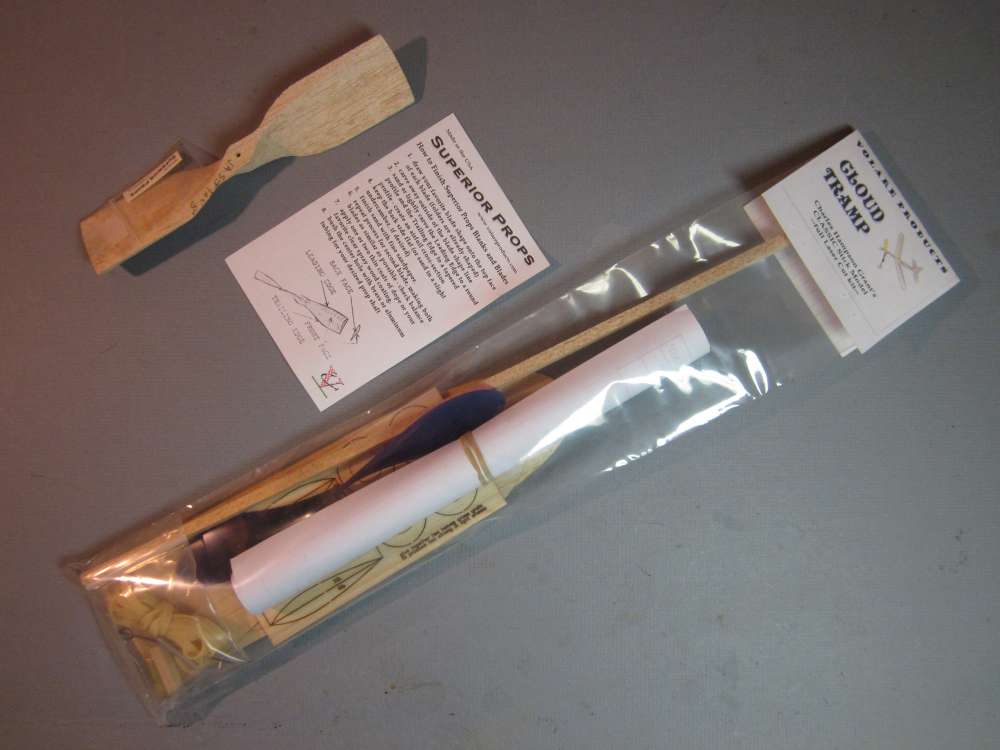 The kit is poly bagged with a card header. I also got the balsa prop. The kit contains a plastic prop.
The kit is poly bagged with a card header. I also got the balsa prop. The kit contains a plastic prop.
Here is what you get. There is a rolled set of plans and instructions. The 1/8″ x 3″ rubber band that came wrapped around the instructions in the older kits was used to hold the wing to the stick. The new kit had a 1/16″ x 2″ rubber band that might cut into the wing edges if used for that purpose. It should be replaced. These wing hold down bands don’t last long in light and air and will have to be replaced anyway. There is a 1/4″ square x 17 7/8″ motor stick of 14# balsa. The original design calls for an 18″ stick. If you are serious about competition, you will want to replace the stick with something lighter. I started with 6# wood and found that it bent unacceptably with a fully wound motor. I found 8# wood acceptable. The kit has 13 9/16″ of 1/32″ steel wire. Adding the labeled lengths on the original plan plus 1/4″ to go across the stick under the nose calls for 13 3/4″. If you start bending up the landing gear according to the plan, you will come up 3/16″ short on the final axle. You can overcome this by using a V bend in the center, under the nose, instead of the square U that seems to be called for on the plan, or you can use your own 1/32″ wire. There is a 3/32″ x 3″ x 6″ sheet of laser cut balsa parts, 1/20″ sheet balsa wings, tailplane and fin, an 8 1/4″, 4.2 gram, blue plastic prop, and a bag of small parts.
The wheels are made from two disks of laser cut 1/8″ balsa, glued together cross grain. That is much easier than chopping down a block and sanding it to shape. You can put a thin box nail through the axle hole, put it in a drill or Dremel chuck and turn it with sandpaper to round the tires.
This kit uses a simplified wing saddle which permits easy wing position adjustment while providing more secure mounting, full span camber and a more stable dihedral. I recommend using 1/16″ medium hard wood for the side plates, with the grain vertical. It uses 1/8″ wing ribs on the 1/20″ sheet wings. Ribs are not necessary if you wet form the wings. This type of dihedral joint maintains both the camber and dihedral.
The 1/20″ sheet parts are lightly laser etched with locating lines. The wing roots have a slight curved gore cut in them to allow the wings to be joined with the proper camber and dihedral.
The small parts consist of 1″ of 1/4″ square balsa, 1″ of 1/8″ i.d. aluminum tube, a Peck prop bearing, a 0.045″ x 2 5/8″ Peck prop shaft, 2 7/8″ of 0.0315″ steel wire and a 0.032″ x 1/4″ x 1″ drilled brass plate prop bearing. Both kits had a strip of 3/16″ rubber, one was 51 1/2″ long and the other was 53 1/4″long.
These parts allow you to chose from two different ways to make the prop bearing. This is the most varied feature of the many Cloud Tramps I have seen. If you use the Peck bearing in the aluminum tube, I suggest you use a second one in the back of the tube. The prop hits things and has a lot of leverage against a small area of support. I recommend against using the single hole bearing. The prop shaft should not be allowed to wobble. This will produce a wobbly flight path, which is not safe if flying in a small park.
The 2 7/8″piece of 0.0315″ steel wire is not long enough to make the motor hook/tailskid. That will require about 3 3/16″, but you have that 11″ piece from the landing gear legs. 😉 George has corrected this problem since early 2014.
The original article calls for 10′ of 1/8″ rubber strip, a 10 gram motor, looped to four strands. This makes a motor of a bit less than 30″. There is some debate about the comparative quality of modern rubber. One obvious difference is that Grant used rubber strip that was 1/30″ = 0.033″ thick, where modern rubber strip is about 0.042″ thick. If we look at the cross section, four strands of 1/30″ x 1/8″is pretty close to four strands of 0.042″ x 3/32″. I recommend that you make a single loop of the 3/16″ rubber provided. You can’t make it into a four strand motor anyway, it won’t fit the 16″ distance between the hooks. I fly my Cloud Tramp on a 32″ long motor with four strands of 3/32″.
There is an 11″ x 17″ plan which shows all the sheet balsa parts at 75% size, shows the two ways to make the prop bearing, shows the simplified wing saddle construction, lists all the materials and gives a construction sequence.
There is a copy of the original construction article from the August 1954 Model Airplane News, including the half size plan. If you looked at the links at the beginning of this article, you will have seen that the original article is available for download from the Volare site. This is easier to read and you can zoom in for a closer look. There are other sources for the plan and instructions online.
Vintage Model Company
Vintage Model Company just introduced their Cloud Tramp kit (January 2017). 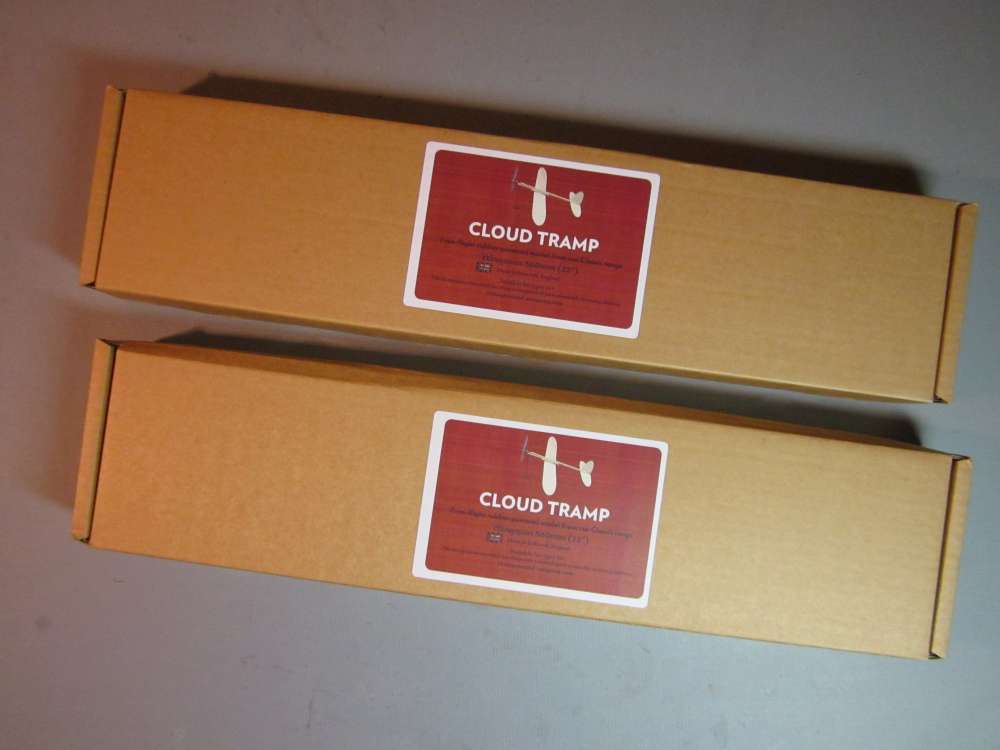
They survived the trip from England to California. Both boxes were slightly crushed by the postal service, but there was plenty of room inside and nothing was damaged.
There is a poly bag of wood parts, a small poly bag of small parts, printed instructions and a thank you note from the manufacturer with contact information if you need help.
The illustrated instructions are clear and complete. A minor typo calls the wing mounts motor mounts. The pictures make it clear what is meant. There is a letter paper printed “decal sheet” with things you can cut out and glue to your airplane. You can also scan and print them on tissue, like the ones shown HERE, and dope that to your plane. That VMC logo would make a nice tail flash.
The large poly bag contains two 1/16″ x 4″ x 18″ sheets of laser cut balsa parts, a 1/16″ x 4″ x 11 1/2″ sheet of laser cut balsa parts, a 1/8″ x 4″ x 5 7/8″ sheet of laser cut balsa parts, 18 1/16″ of 0.0275″ steel wire, two 1/8″ x 11/16″ x 3 1/4″ plywood wing camber jigs, a 6″ length of 3/32″-1/8″ x 3/8″ trailing edge stock, and 18″ of 1/4″ square balsa. The balsa density ranges from 7# to 10#.
The trailing edge stock is to be cut in half and glued back to back to a base plate to form the dihedral block. This is easier and more reliable than carving down a bigger block of wood by hand. There are five nose block pieces which are laminated to make the holder for the prop bearing. This is a new addition to the several propeller bearings already tried. I found the plastic prop bearing to be slightly loose in the hole. This can be tightened with a paper ring around the bearing. I would recommend using a similar bearing at the back end of the nose block. The propeller will hit things and it has a lot of leverage against the short bearing barrel in soft wood.
The wings and tail are lightly etched with location lines. The wing mount conforms with the original plan. There is enough material in the kit that you can make the improved wing mount. The 1/8″ ply wing camber formers should make it a lot easier to glue the wing ribs in place.
The small parts bag contains a 7 7/8″, 4.9 gram plastic prop, four plastic half wheels that weigh 4.3 grams when assembled, a small plastic prop shaft bushing, a 2″ wing hold down rubber band, 5 5/8″ of 0.036″ steel wire, a 2 3/8″, 0.047″ diameter steel wire prop shaft with a 5/16″ diameter rubber hook, two 1/16″ x 3 1/8″ cocktail sticks, 12 7/8″ of transparent 0.01″ monofilament and a strip of 3/16″ rubber that was 48 3/4″ long in one kit and 50 3/4″ long in the other.
The cocktail sticks are to protect the wing edges from being gouged by the tight hold down rubber band.
The monofilament is presumably to wrap the nose block and hold the landing gear onto the stick. I’m wondering how successful that would be. Monofilament does not accept glue well. The illustrations show heavy black thread being used. I used cotton kite string for mine.
The original article calls for 10′ of 1/8″ rubber strip, a 10 gram motor, looped to four strands. This makes a motor of a bit less than 30″. There is some debate about the comparative quality of modern rubber. One obvious difference is that Grant used rubber strip that was 1/30″ = 0.033″ thick, where modern rubber strip is about 0.042″ thick. If we look at the cross section, four strands of 1/30″ x 1/8″is pretty close to four strands of 0.042″ x 3/32″. I recommend that you make a single loop of the 3/16″ rubber provided. You can’t make it into a four strand motor anyway, it won’t fit the 16″ distance between the hooks. I fly my Cloud Tramp on a 32″ motor with four strands of 3/32″.
Conclusion
Either of these kits will allow you to build a flyable Cloud Tramp. You always have the option of making them per kit plan and material or to make any of the modifications suggested. Even if you replace almost everything else, the laser cut flying surfaces will cut your building time down significantly.
I have a new way of holding the wheels on the axles. I use a leather punch to make 1/8″ disks from HDPE can lids. I push a pin through the center of the disk. The disk is forced over the end of the wire axle. It grips tightly enough to stay on, yet the wheel can be removed and replaced without bending the wire.
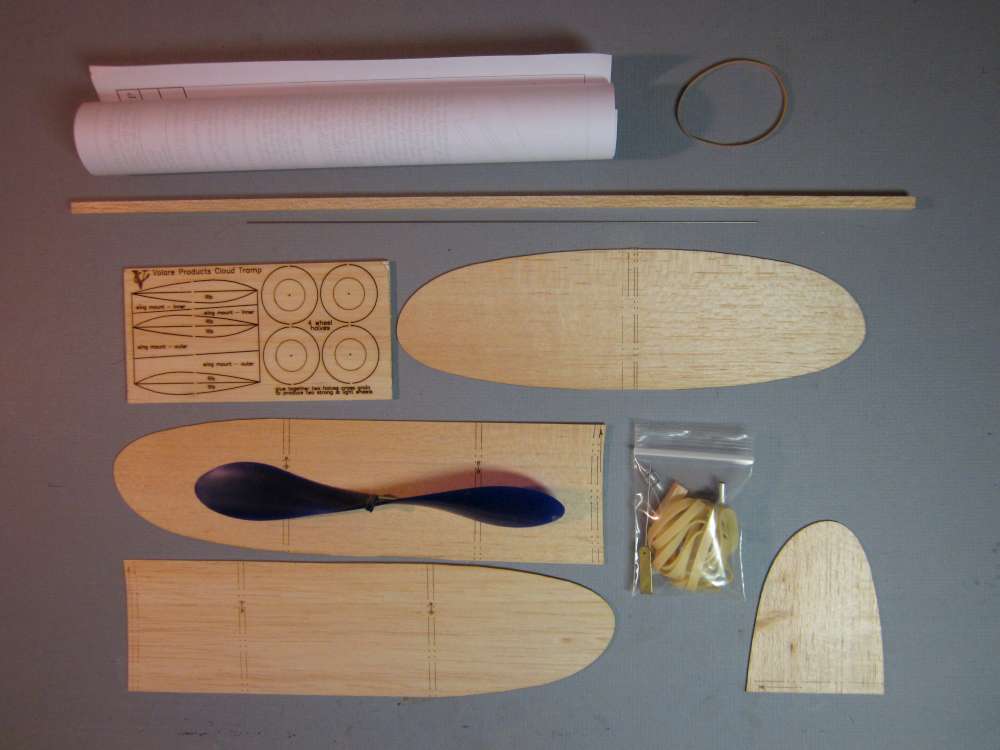
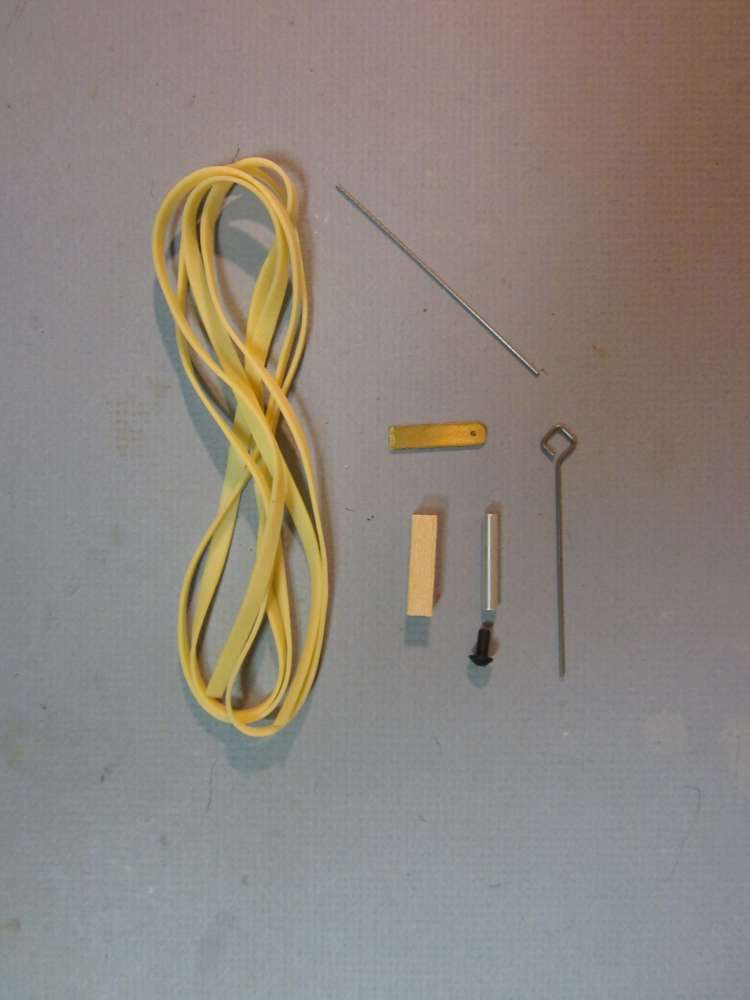
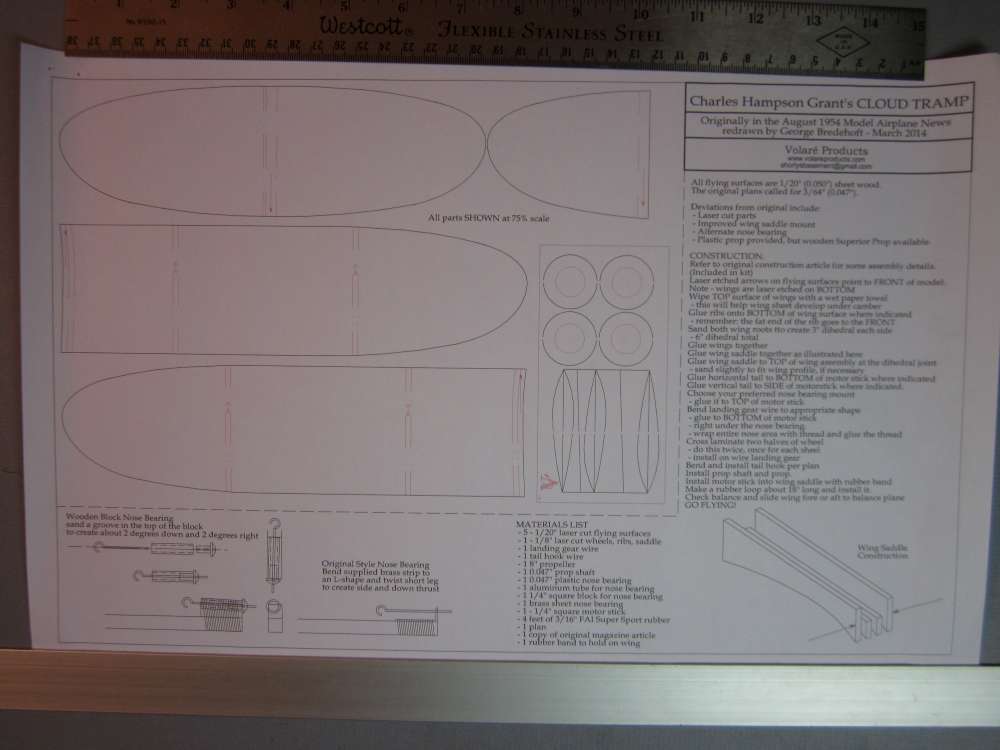
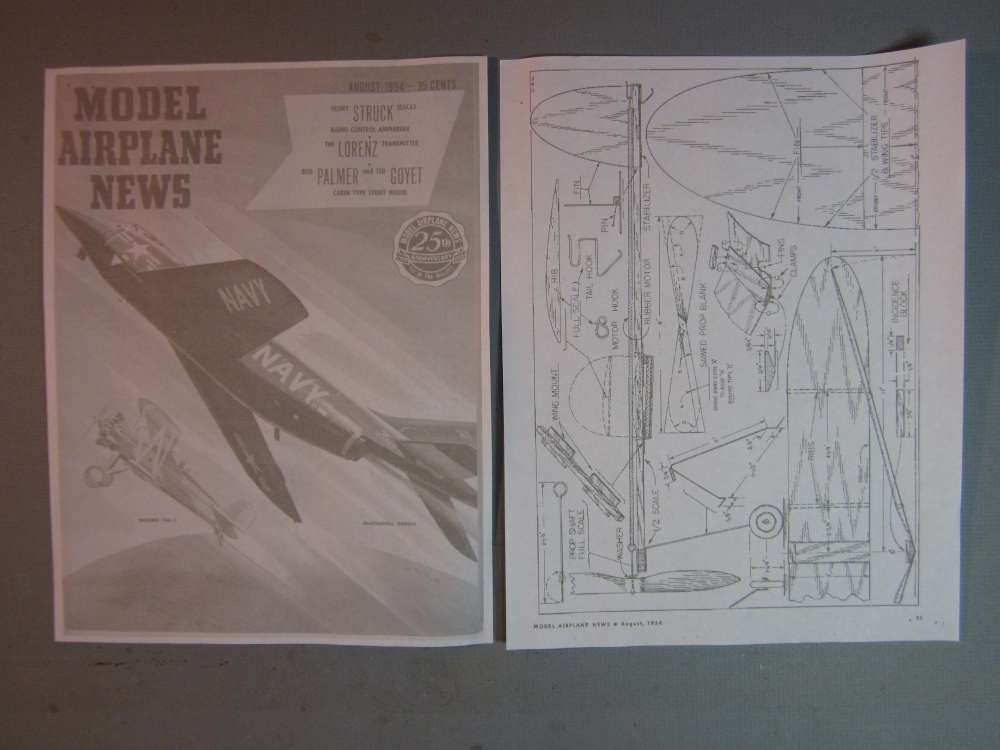
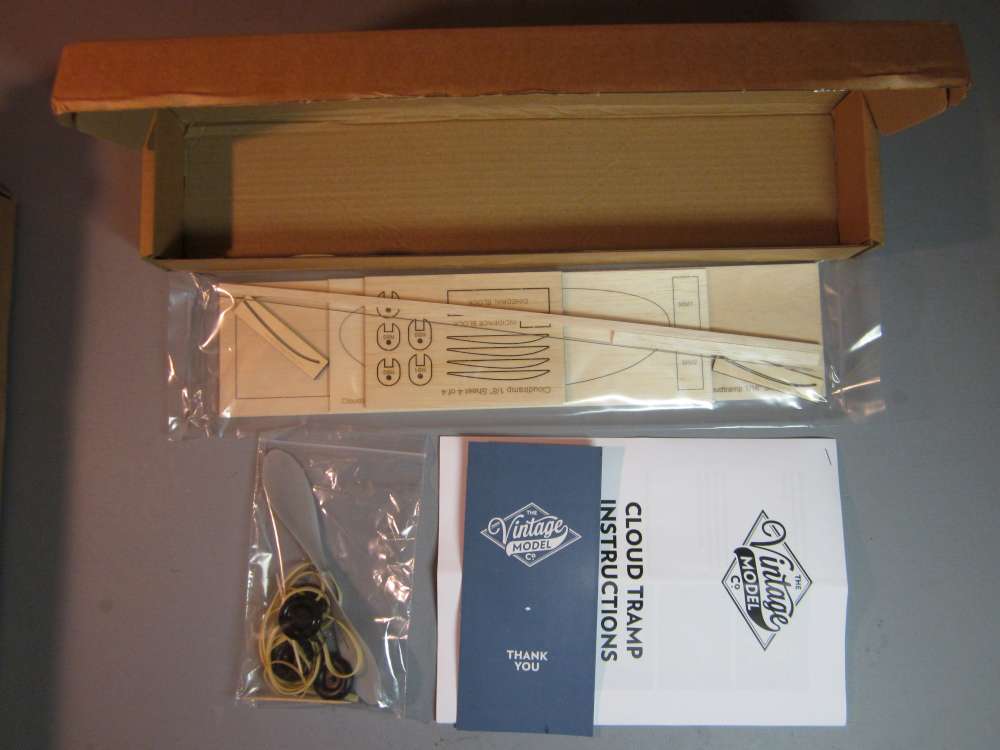
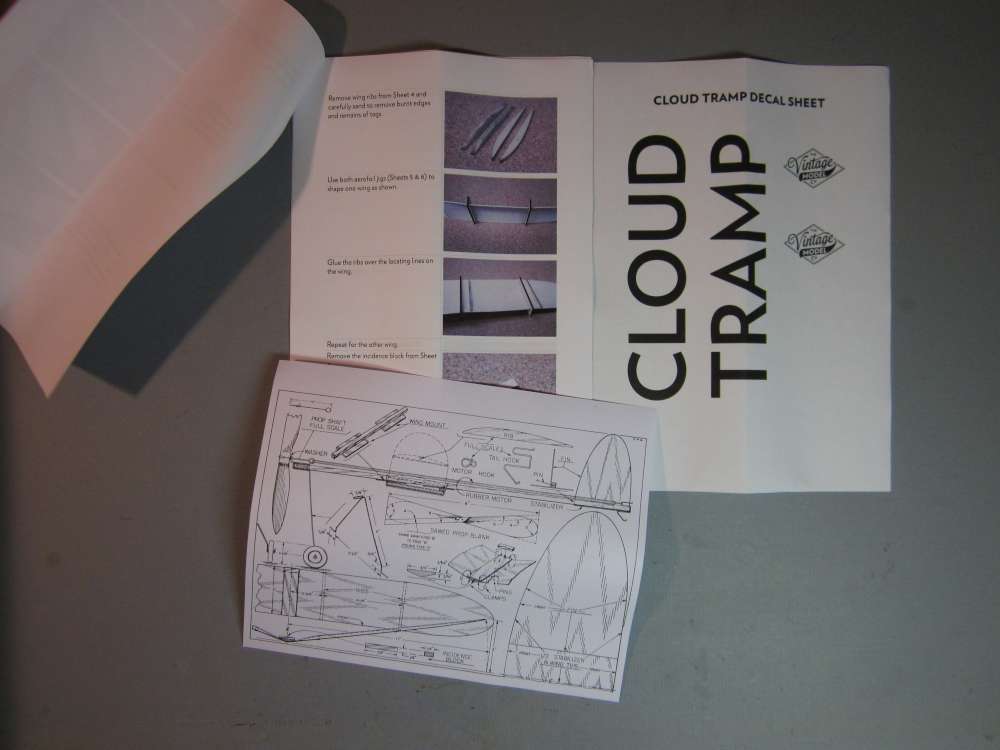
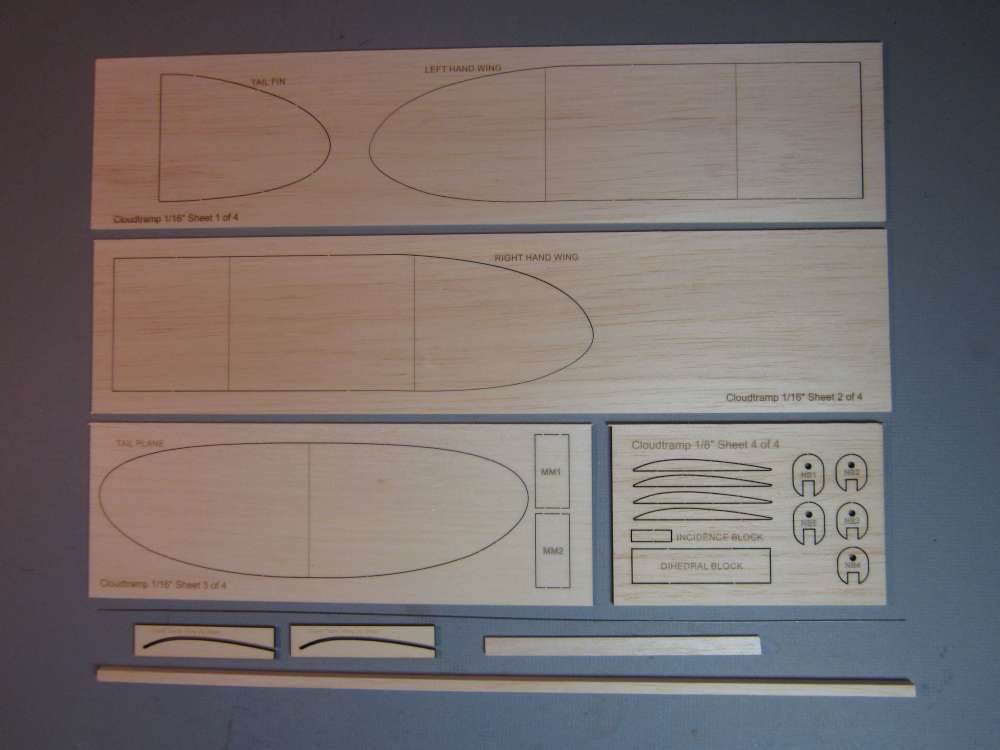
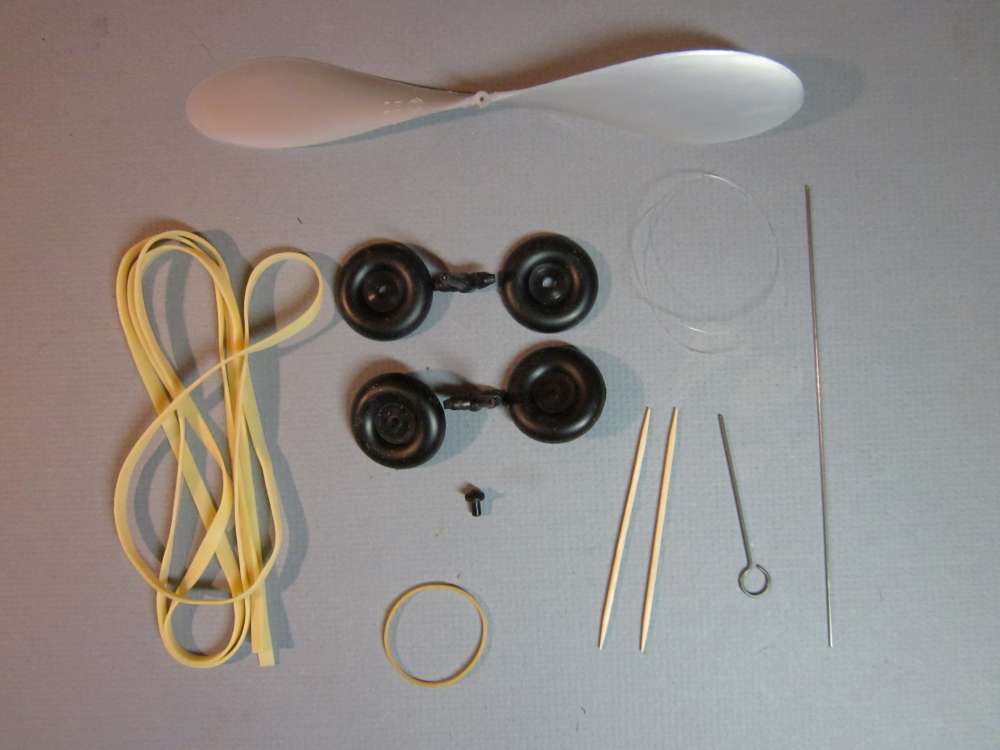
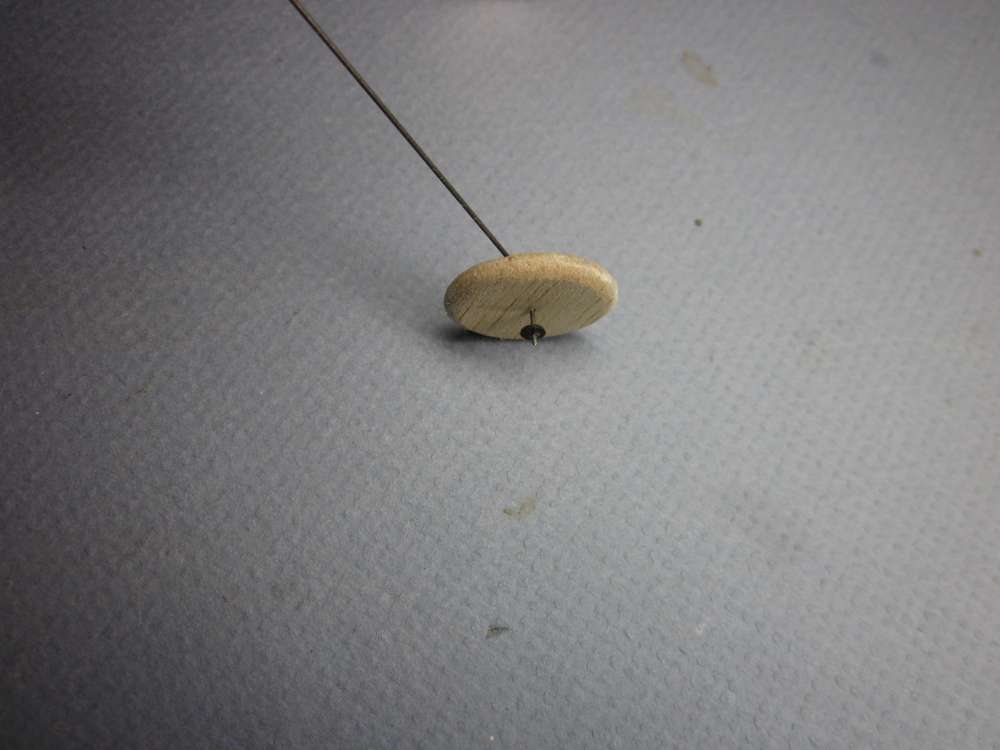
What is the price. of the VMC kit?
£19.80
That article must be updated. George is no longer providing a full kit, but he has a short kit consisting of the laser cut sheet parts. The VMC link does not work, but you can go to their site and search ‘Cloud Tramp’. Here is the current link: https://www.vintagemodelcompany.com/22-cloud-tramp
I bought a short kit from George and it is a very nice kit and currently I am using it to building the Tramp and having no problems. It is a quality product, exactly what you expect from Volare .
Joe
I built the Guillow’s Arrow. At least I have the rudder, wing and stabilizer done. The hull was poorly designed and if built according to plan will EXPLODE after about 35 turns when winding up. So, what I have done is to rebuild my hull/fuselage with heavy strip balsa and added structures for strength and rigidity. I should get 300+ turns when winding her up and she should have no problem staying afloat for at least 2 min. I will keep you posted. I do not think anyone should buy a kit, even one made in England. So, I recommend just looking at this site and learning how to scratch build your own plane and have good fun doing it.
Having built the Vintage version, which flew well although the nose block is very fragile,
and the wing mount wobbly, I wonder if the US version flies better by reason of the full span camber?
Is there an outlet for the Volare version in the UK?
Kind regards
Clive
Many things enter into flight performance, but the full span camber must be better than the flat center section. I suggest you contact George Bredehoft at Volare and ask him about shipping to the UK.
The wing saddle for full span camber is not difficult to make. It is shown HERE on EndlessLift.
The Vintage nose block is fragile and unnecessarily complex. Fortunately it is easy to replace with something stronger and simpler. The simplest would be a block of hard balsa with a bit of brass tube glued into a groove, wrapped in cotton string. I prefer to use a two hole bearing made from a cotter pin, as shown HERE.